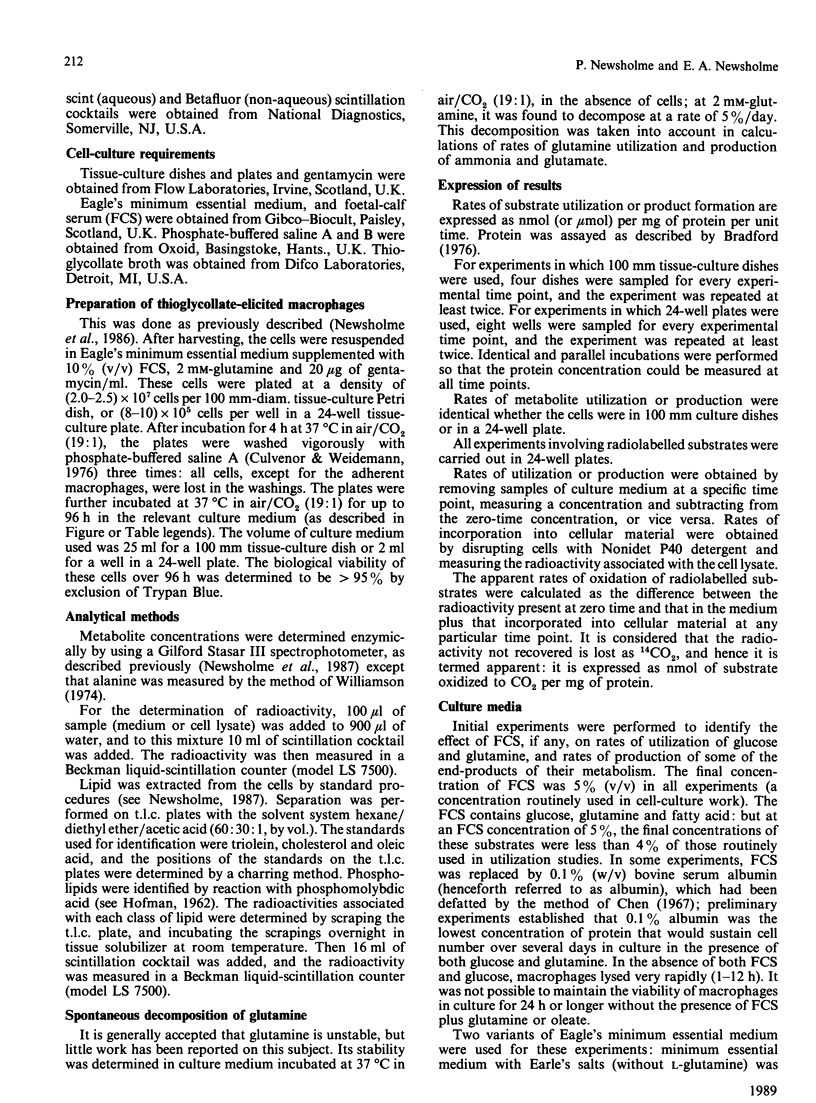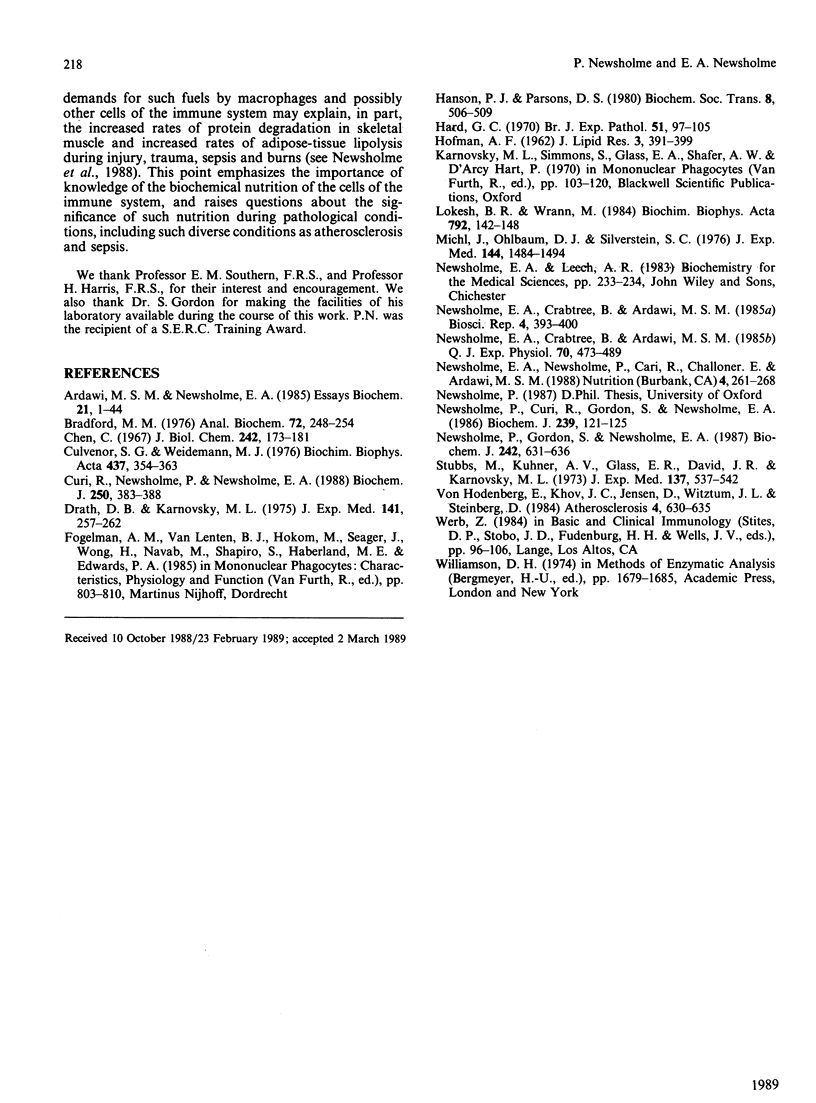Abstract
1. The metabolism of mouse thioglycollate-elicited peritoneal macrophages was studied in culture for up to 96 h. 2. The rates of glycolysis, lactate formation and glutamine utilization were approximately linear with time for at least 80 h of culture. 3. The rates of glucose and glutamine utilization by cultured macrophages were approx. 500 and 90 nmol/h per mg of protein respectively. This rate of glucose utilization is at least 50% greater than that previously reported for macrophages during 60 min incubation in a shaking flask; and it is now increased by addition of glutamine to the culture medium. The rate of glutamine utilization in culture is similar to that previously reported for macrophages during 60 min incubation. The major end-product of glucose metabolism is lactate, and those of glutamine metabolism are CO2, glutamate, ammonia and alanine. 4. Oleate was utilized by these cells: 14C from [14C]oleate was incorporated into CO2 and cellular lipid. The highest rate of oleate utilization was observed when both glucose and glutamine were present in the culture medium. The presence of oleate in the culture medium did not affect the rates of utilization of either glucose or glutamine. Of the [14C]oleate incorporated into lipid, approx. 80% was incorporated into triacylglycerol and only 18% into phospholipid. 5. The turnover rate for the total ATP content of the macrophage in culture is about 10 times per minute: the value for the perfused isolated maximally working rat heart is 22. This indicates a high metabolic rate for macrophages, and consequently emphasizes the importance of the provision of fuels for their function in an immune response.
Full text
PDF







Selected References
These references are in PubMed. This may not be the complete list of references from this article.
- Ardawi M. S., Newsholme E. A. Metabolism in lymphocytes and its importance in the immune response. Essays Biochem. 1985;21:1–44. [PubMed] [Google Scholar]
- Bradford M. M. A rapid and sensitive method for the quantitation of microgram quantities of protein utilizing the principle of protein-dye binding. Anal Biochem. 1976 May 7;72:248–254. doi: 10.1016/0003-2697(76)90527-3. [DOI] [PubMed] [Google Scholar]
- Chen R. F. Removal of fatty acids from serum albumin by charcoal treatment. J Biol Chem. 1967 Jan 25;242(2):173–181. [PubMed] [Google Scholar]
- Culvenor J. G., Weidemann M. J. Phytohaemagglutinin stimulation of rat thymus lymphocytes glycolysis. Biochim Biophys Acta. 1976 Jul 21;437(2):354–363. doi: 10.1016/0304-4165(76)90005-2. [DOI] [PubMed] [Google Scholar]
- Curi R., Newsholme P., Newsholme E. A. Metabolism of pyruvate by isolated rat mesenteric lymphocytes, lymphocyte mitochondria and isolated mouse macrophages. Biochem J. 1988 Mar 1;250(2):383–388. doi: 10.1042/bj2500383. [DOI] [PMC free article] [PubMed] [Google Scholar]
- Drath D. B., Karnovsky M. L. Superoxide production by phagocytic leukocytes. J Exp Med. 1975 Jan 1;141(1):257–262. doi: 10.1084/jem.141.1.257. [DOI] [PMC free article] [PubMed] [Google Scholar]
- Hanson P. J., Parsons D. S. The interrelationship between glutamine and alanine in the intestine. Biochem Soc Trans. 1980 Oct;8(5):506–509. doi: 10.1042/bst0080506. [DOI] [PubMed] [Google Scholar]
- Hard G. C. Some biochemical aspects of the immune macrophage. Br J Exp Pathol. 1970 Feb;51(1):97–105. [PMC free article] [PubMed] [Google Scholar]
- Lokesh B. R., Wrann M. Incorporation of palmitic acid or oleic acid into macrophage membrane lipids exerts differential effects on the function of normal mouse peritoneal macrophages. Biochim Biophys Acta. 1984 Feb 9;792(2):141–148. doi: 10.1016/0005-2760(84)90215-7. [DOI] [PubMed] [Google Scholar]
- Michl J., Ohlbaum D. J., Silverstein S. C. 2-Deoxyglucose selectively inhibits Fc and complement receptor-mediated phagocytosis in mouse peritoneal macrophages II. Dissociation of the inhibitory effects of 2-deoxyglucose on phagocytosis and ATP generation. J Exp Med. 1976 Dec 1;144(6):1484–1493. doi: 10.1084/jem.144.6.1484. [DOI] [PMC free article] [PubMed] [Google Scholar]
- Newsholme E. A., Crabtree B., Ardawi M. S. Glutamine metabolism in lymphocytes: its biochemical, physiological and clinical importance. Q J Exp Physiol. 1985 Oct;70(4):473–489. doi: 10.1113/expphysiol.1985.sp002935. [DOI] [PubMed] [Google Scholar]
- Newsholme P., Curi R., Gordon S., Newsholme E. A. Metabolism of glucose, glutamine, long-chain fatty acids and ketone bodies by murine macrophages. Biochem J. 1986 Oct 1;239(1):121–125. doi: 10.1042/bj2390121. [DOI] [PMC free article] [PubMed] [Google Scholar]
- Newsholme P., Gordon S., Newsholme E. A. Rates of utilization and fates of glucose, glutamine, pyruvate, fatty acids and ketone bodies by mouse macrophages. Biochem J. 1987 Mar 15;242(3):631–636. doi: 10.1042/bj2420631. [DOI] [PMC free article] [PubMed] [Google Scholar]
- Stubbs M., Kühner A. V., Glass E. A., David J. R., Karnovsky M. L. Metabolic and functonal studies on activated mouse macrophages. J Exp Med. 1973 Feb 1;137(2):537–542. doi: 10.1084/jem.137.2.537. [DOI] [PMC free article] [PubMed] [Google Scholar]
- von Hodenberg E., Khoo J. C., Jensen D., Witztum J. L., Steinberg D. Mobilization of stored triglycerides from macrophages as free fatty acids. Arteriosclerosis. 1984 Nov-Dec;4(6):630–635. doi: 10.1161/01.atv.4.6.630. [DOI] [PubMed] [Google Scholar]


